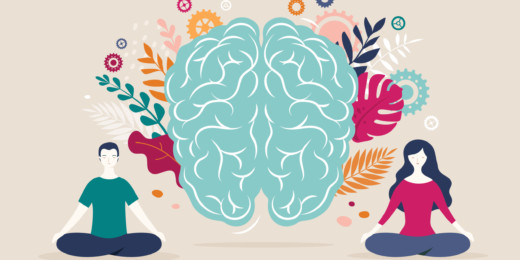We all get moody -- it's part of human nature. But if you have people in your life afflicted with bipolar disorder, you quickly realize that not all moodiness is created equally.
An estimated 4.4% of adults in the U.S. -- nearly 50 million people -- will be diagnosed with a mood disorder that falls into the bipolar classification.
While there are many medications to help these people find a sweet spot between their fluctuating moods -- from a manic state of high energy to an often paralyzingly depressive low -- those pharmacological interventions are riddled with adverse effects and can be tricky to dial in, if they work at all. That helps explain why, despite the condition's debilitating nature, it's estimated that half of patients diagnosed with bipolar eventually stop taking medications.
Stanford Medicine researchers have been among early pioneers to home in on bipolar research and treatment thanks to Terence Ketter, MD, emeritus professor of psychiatry and behavioral sciences (psychopharmacology), who launched the Bipolar Disorders Clinic in 1995 and drew international attention for his research and seminal authorings on the neurobiology of mood disorders.
"Terry really believes bipolar is a biological disease, so he wanted to address that from a neurological standpoint," said Po Wang, MD, clinical professor of psychiatry and behavioral sciences. "He was able to grow that neurobiological understanding that this was a serious illness that required very specific treatments."
[Terence Ketter] was able to grow that neurobiological understanding that this was a serious illness that required very specific treatments.
Po Wang
Wang, who was the clinic's director before handing the reins to Kristin Raj, MD, clinical associate professor of psychiatry and behavioral sciences, said he joined Stanford as a resident 25 years ago because Ketter was pushing the understanding of the disease via neuroimaging, something Wang felt was key to understanding bipolar.
In subsequent years, they moved their focus to pharmacological and talk therapy treatments, and now they're working more closely with colleagues like Nolan Williams, MD, associate professor of psychiatry and behavioral sciences, who has innovated the approach to neuromodulation, more commonly referred to as transcranial magnetic stimulation, or TMS.
March is Bipolar Awareness Month, so Wang agreed to share some of what he's learned in his quarter century of studying and helping others comprehend the still little-understood disorder that he said presents a "constellation of symptoms." It also can be deadly: Researchers estimate as many as 60% of individuals with bipolar will attempt suicide and as many as 20% will die by suicide.
Part of the extra burden bipolar carries is that it's a condition often misdiagnosed and heavily stigmatized in media portrayals because of its enigmatic presentation -- something Wang attributes to the disease's unique complexity.
It's not just pejoratively saying 'They went off the deep end' or 'They had a really bad day.' Bipolar disorder a serious biological condition that requires serious treatment, not unlike cancer or heart disease.
Po Wang
"The idea of bipolar as a mood spectrum disorder, where moods just fluctuate up and down, has diluted the seriousness of the condition," Wang said. "It makes it too easy to equate someone feeling some level of moodiness to someone who needs to be hospitalized because their mania has turned into psychosis. It's not just pejoratively saying 'They went off the deep end' or 'They had a really bad day.' Bipolar disorder a serious biological condition that requires serious treatment, not unlike cancer or heart disease."
This interview has been edited for clarity and brevity.
You and Terence Ketter were able to pinpoint the key brain regions responsible for bipolar disorder many years ago.

The circuits involved in mood disorders are pretty well established, but they tend to be deep in the brain in an area called the paralimbic zone. We did a few neurosurgical interventions back then, but they were invasive and not practical for most patients. In recent years, TMS, even though it doesn't seem to go very deep, acts via the more superficial areas of the cortex to influence the same circuits we identified in earlier studies.
Might what Karl Deisseroth and the Human Neural Circuitry Program are doing have applications for bipolar?
I think it's a little early to think of therapeutics [with the HNC], but we said the same about TMS. We need technology to get us deeper into the brain. Most of the serious psychiatric illnesses tend to involve the deeper structures. Getting to that cellular level like Karl [Deisseroth, MD, PhD, the D. H. Chen Professor and a professor of bioengineering and of psychiatry and behavioral sciences] is doing is where you want to be. You want to see how these things work in real time.
- Human Neural Circuitry program seeks to investigate deepest mysteries of brain function, dysfunction
What do you think the general population should know about bipolar but probably doesn't?
Unlike anxiety and depression, where there's typically a strong environmental component, bipolar disorder has a strong biological component. What someone with bipolar experiences from minute to minute, day to day, they can't control. People think they should be able to manage bipolar disorder themselves, but they really can't. They can influence it by getting treatment and living a healthy lifestyle. It's really something they have to accept, then work with a psychiatrist to somehow manage the illness. With bipolar, there is a lot of disability, and this can be a life-threatening condition.
How important is it to find a good treatment plan?
The treated course of illness is much, much better than untreated. With treatment, people can do quite well in their lives. If we're aggressive in treatment, people can do extremely well. But it's a collaborative approach: The person has to be willing to manage bipolar disorder and engage in it as an illness -- with medications, with psychotherapy, with sleep, with diet and exercise, and engaging social contact.
The person has to be willing to manage bipolar disorder and engage in it as an illness -- with medications, with psychotherapy, with sleep, with diet and exercise, and engaging social contact.
Po Wang
Talk about the value of psychotherapy in bipolar.
The best studies are on three forms of psychotherapy -- cognitive behavioral therapy, family-focused therapy, and interpersonal and social rhythm therapy -- that have been proven to shorten the time of bipolar depression and extend the time of stable mood. One thing I tell people is that none of those studies have been done with patients not on medication. Because this is so biological, you've got to have that foundational medication first. But you've got to also have some type of therapy, just like physical therapy for a cardiac or orthopedic patient. For bipolar patients, it's psychotherapy.
It seems like there's a societal disconnect when it comes to understanding bipolar -- even for those who have it.
Psychoeducation -- that is very important. People come in and feel like they have this level of sadness or happiness that should relate to what's going on in their lives -- when really what they're feeling is largely biological. They feel that they're responsible for how they're feeling. Actually, they are responsible for getting treatment and focusing on the things that can change their lives.
Since we, as psychiatrists, don't have a lot of lab tests at our disposal, we have to be good at identifying symptoms as a medical entity and what they mean. I try to teach my patients to identify symptoms. If there is a constellation of them, we might need to ask, "Are we in an episode?" ... "Do we need a specific intervention?" The best outcomes require a very collaborative approach.
Image: woocat
Po Wang spoke about bipolar during a National Association of Mental Illness webinar in January. Here's the link to the video on YouTube.






